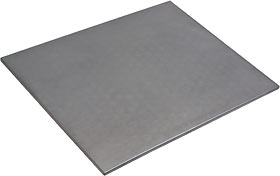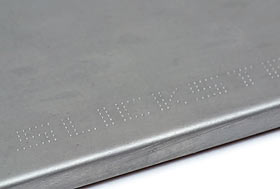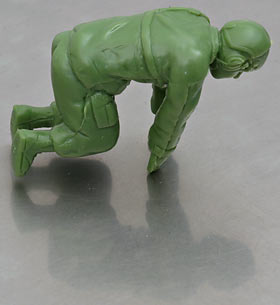
Quick Shot review 8:
Slicksteel mouse pad
Review date: 1 November 2003.Last modified 03-Dec-2011.
Another day, another funny mousemat.
Slicksteel may not (as I write this) have the snazziest of Web sites, but they make a solid mousing surface, and it's cheap, too.
The top of the Slicksteel pad is 304 stainless steel...
...and the bottom's cork. This lets the pad sit moderately still on most desks, but it's not nearly as immovable as a mat with a soft rubber back. A dab or two of the adhesive of your choice will be needed to keep it really stationary.
This is the Standard Slicksteel pad, 24 by 19cm (9.4 by 7.5 inches) in size. This puts it in the same size class as other small-to-medium mats, like Everglide's classic oval Attack Pad; it's quite big enough for most users.
The current Attack Pads, though, weigh less than 220 grams (7.8 ounces). The Slicksteel weighs in at almost 370 grams (13 ounces). This, and its right angle corners, make it clearly superior for use as a murder weapon.
If you want a bigger pad than the Standard model, Slicksteel offer a "Pro" variant that's 29 by 20cm (11.4 by 7.9 inches), with a wrist-rest cutout on the bottom edge. It's aluminium-backed, with rubber feet.
By exotic mousemat standards, these ones are very inexpensive, but shipping pushes the price up for people who don't live in the UK, where Slicksteel are.
The Standard Slicksteel pad sells for £6.99 (UK pounds), the Pro pad is £14.99. Delivery varies from £2.99 to £7.99 depending on where you are. US buyers who want a Standard Slicksteel pad are looking at around $US25.50 including delivery, at current exchange rates; Aussies will pay around $AU36.
The Slicksteel mat is a simple object, but its manufacturing quality is top notch. The steel it's made of is only about three quarters of a millimetre thick, but it's folded down on all four sides so that less than a millimetre of cork shows around the bottom. The folded edges make the mat more than sufficiently rigid to keep its surface very flat, provided you don't manage to drop it on soft carpet and tread in the middle of it, or something.
But does it work?
Given the, well, slickness of the Slicksteel pad, I was wondering how well the thing would actually work with an optical mouse.
The Slicksteel pad doesn't have a mirror finish, but its hand-polished surface is shiny enough...
...(as this narcissistic commando demonstrates) that you'd think optical mouses would have a hard time tracking on it. Modern optical mouses have a little camera and Digital Signal Processor unit that looks at the surface under the mouse and figures out which way it's moving; there's an oblique LED illuminator to throw surface detail into sharp relief and make it easier to track, but that doesn't help on smooth reflective surfaces. On a reflective surface, all the camera sees is a reflection of itself.
I was pleased, therefore, to note that my Intellimouse Explorer 3.0 (reviewed here, almost two years ago now) tracked perfectly on the Slicksteel pad. No problems at all. If you've got a dodgy old off-brand optical then you might, perhaps, have issues, and metal mats can also cause problems with radio-frequency cordless mouses, but for most users I think the surface will work fine, at least as far as tracking goes.
The Slicksteel surface is smooth enough that a mouse will slide on it about as easily as it will on a textured hard plastic pad. It makes a bit more noise, though.
OK. Now the bad news.
Flat, textureless surfaces are not good for moving a mouse around on, unless you're sitting in an operating theatre, chip fabrication plant or Swiss watch assembly room. Anywhere else, little bits of dust and dirt will get on the pad.
On a textured pad, gunk can fall into the numerous tiny valleys and not interfere with the points of contact between mouse and pad. You do have to clean any pad from time to time, and it's not as if you can eat crumbly snacks over the pad with impunity, but in normally dusty environments you won't have to clean a textured pad all the darn time.
On a smooth pad, though, there's nowhere for dirt to go. It just rolls around between the mouse feet and the pad. This creates a nasty gritty feeling, and doesn't do the mouse feet any good either. So you'll have to clean the pad much more often.
I also didn't much care for the cold-steel-under-the-hand feeling of the Slicksteel's surface; it's like using your computer in a commercial kitchen. But I dare say that's just a matter of taste.
If you don't mind using your mouse on untextured surfaces - like, for instance, a plain old desk with no pad on it at all - then the Slicksteel surface may well appeal to you. It works fine with optical pickups, it's undeniably more durable than any plastic surface (frankly, I can't imagine it ever wearing out), and it's not very expensive, considering how nicely made it is.
I think untextured mouse pads are fundamentally flawed, though. If you like dusting your mouse pad all the time, you may disagree.
If Slicksteel can come up with a stainless steel duplicate of a textured plastic pad, they'll have a real winner on their hands. The smooth version just seems too much like hard work to me, though.
Review pad kindly provided by Slicksteel.





